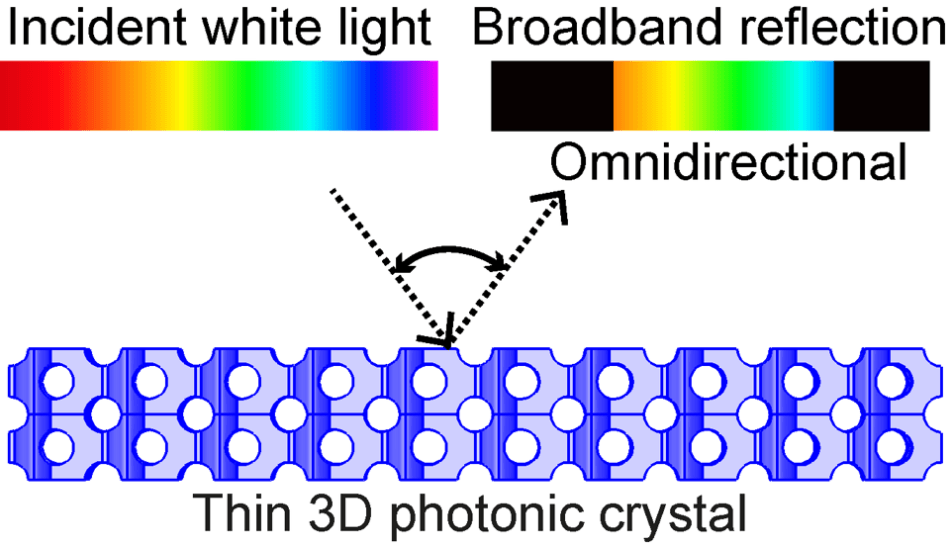May 2 2017
Through improved calculations, physicists and mathematicians at the University of Twente have recently discovered that a thin, diamond-like photonic nanostructure is capable of reflecting an unexpected broad range of colors of light, from all angles. This causes the material to have immense potential as a back reflector in order to improve the efficiency of tiny on-chip light sources or solar cells.
 A thin 3D photonic crystal with a diamond-like nanostructure is illuminated by white light from any incident direction (black arrow). Many colors are strongly reflected omnidirectionally irrespective of the incident angle (black arrow). In this example, these are the colors from orange to blue. Credit: University of Twente
A thin 3D photonic crystal with a diamond-like nanostructure is illuminated by white light from any incident direction (black arrow). Many colors are strongly reflected omnidirectionally irrespective of the incident angle (black arrow). In this example, these are the colors from orange to blue. Credit: University of Twente
The results were featured in the April 26 issue of the leading physics journal Physical Review B.
The efficiency of solar cells relies on trapping and absorbing light and can further be increased with the help of a back reflector, which refers to a mirror placed behind the solar cell material that light that was not absorbed and sends it back into the solar cell. The perfect mirror reflects light incident from any angle, called omnidirectional reflectance, and for all frequencies (or colors) of light. Such omnidirectional reflectance for dielectric structures is linked with three-dimensional photonic crystal nanostructures that in fact sustain a so-called complete photonic band gap. Researchers have for a long time assumed that such structures would have a narrow frequency range of operation and that their omnidirectional behavior has not been described till date.
Recently, advanced calculations were carried out by an interdisciplinary team of physicists and mathematicians from the University of Twente on an immensely promising material produced in the Complex Photonic Systems group.
We studied so-called inverse woodpile photonic crystals. These crystals consist of regularly ordered array of pores drilled in two perpendicular directions in a wafer of dielectric such as silicon. The crystal structure is inspired by diamond gemstones.
PhD student Devashish.
The reflectivity of the cubic diamond-like inverse woodpile crystals was studied by the researchers through numerical calculations and also be interpreting recent experiments. The finite element method was used by the team to study these crystals surrounded by free space.
We found that even very thin inverse woodpiles strongly reflect many colors of light omnidirectionally. In inverse woodpiles, the absorption of light is negligible. This makes them a great candidate as a back reflector in solar cells. We also expect these diamond-like photonic crystals may lead to on-chip lasers, invisibility cloaks and devices to confine light in extremely small volumes.
Devashish
The Team
The research was executed by Devashish M.Sc., Dr. Shakeeb Hasan, Prof. Dr. Jaap van der Vegt and Prof. Dr. Willem Vos from the Complex Photonic Systems (COPS) Chair, MESA+ Institute for Nanotechnology, University of Twente, The Netherlands and Mathematics of Computational Science (MACS), MESA+ Institute for Nanotechnology, University of Twente, The Netherlands. The Shell-NWO/FOM Program “Computational Sciences for Energy Research” (CSER) supported the research project.
The Paper
The paper is entitled “Reflectivity calculated for a three-dimensional silicon photonic band gap crystal with finite support” and was featured in Physical Review B on April 26, 2017.